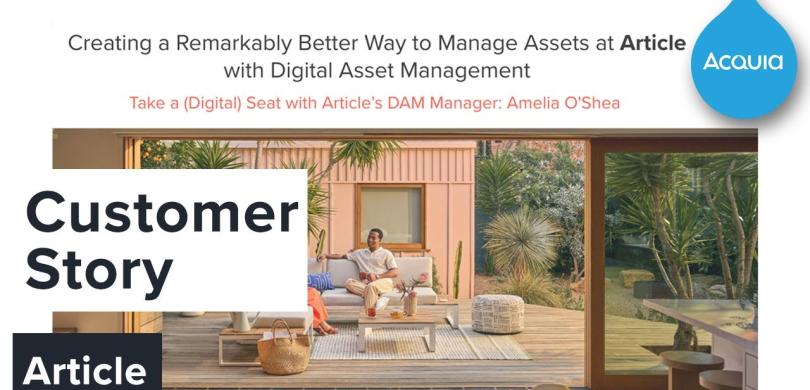
Article
Acquia DAM (Widen), with the Assets, Insights, and Portals applications, and integrations.

assets
downloads in the last 12 months
searches in the last 12 months
The Client
Article is an e-commerce business that makes delightful designs for every home. Through their unique direct-to-consumer model, they offer high-quality, modern furniture and decor at exceptional value.

The Situation
With over 900 employees, Article has delivered products to more than 1.5 million North American homes and businesses. And as Article’s business has grown, so has their need for content.
The Challenge
However, workflows were strained without the support of the right tools and processes.
“We had assets on our server, as well as Google Drive. Assets were delivered to the press via Google Drive and for projects via Slack,” shared Amelia O’Shea, Article’s Digital Asset Management Implementation Manager. With content dispersed across systems, locating the right image was often done by memory.
“There were unclear usage rights,” she continued, “low visibility for searching, very slow speeds on the server, and documentation was limited. There was a huge need for many upgrades.”
The Solution
Article decided to invest in software solutions, including digital asset management (DAM), to scale and streamline workflows. And in 2021, they implemented Acquia DAM.
Everything organized in one system
Shortly after Acquia DAM was selected, Amelia was hired to lead their DAM implementation. Their brand team named the system ADAM — short for Article digital asset management — and with the help of two digital migration coordinators, all of their final assets were uploaded into the system.
Acquia DAM quickly became their central source of truth for all brand and marketing content. “All of our final assets are on ADAM, they are easily searchable. There are categories on the side that can be used to narrow down your search,” said Amelia. “Things are just getting remarkably better with ADAM.”
Integrations with Google Drive, Slack, CI-HUB, and PIM
Integrating Acquia DAM with other key marketing technology (martech) tools has allowed Article to infuse speed across a range of content workflows. Their current integrations include:
- Google Drive: Assets that are put into certain folders on Google Drive are instantly uploaded to Acquia DAM in the correlating collection, eliminating a significant manual step. “This is one of my favorite integrations so far,” Amelia shared.
- Slack: When new assets are uploaded to Acquia DAM — either manually or via Google Drive — a message with a link to the collection is sent to the appropriate Slack channel to notify teams and individuals. “So it's a much quicker process to see it on Slack compared to if you're trying to find it in your email,” Amelia explained.
- CI-HUB: The CI-HUB integration allows teams to access assets in Acquia DAM from within other platforms, and Article is currently using it with InDesign and Figma. The CI-HUB panel appears inside these platforms and allows users to browse, select, and import assets without toggling between systems, creating time-saving efficiencies.
- Product information management: The integration between Article’s in-house product information management (PIM) system and Acquia DAM allows key product details — including the product name, status, color, fabric, room, material, and style — to be pulled into the correlating metadata fields in the DAM platform, using the product SKU. Syncing this information between systems helps Article create an accurate and consistent customer experience across touchpoints.
Portals for streamlined distribution
Before Article implemented Acquia DAM, they lacked an effective way to distribute content to external stakeholders. But with the Portals application, they’re able to share a selection of assets with specific audiences, such as 3D vendors and the press, via a simple URL.
They also use Portals to share information internally. Their DAM Information Portal, for example, gives all employees access to process documents and training videos.
The Results
Optimized workflows
By integrating Acquia DAM with other essential tools, Article has accelerated their content operations across their organization. For example, they were able to streamline their advertising workflow. “This took three to four hours per week,” Amelia explained. “It was a very manual process.”
Now, instead of five steps, it’s just one: once the files are saved in Google Drive, they are instantly uploaded to the right collection in the DAM system. From there, a CSV file is automatically pulled into the advertising feed, using the DAM API, and then content is published across digital channels. That’s it! “Most of it is automated and there's really much less work that needs to be done,” Amelia shared.
Speed and efficiency
With Acquia DAM, teams across Article are empowered to find the assets they need, whenever they need them. They can use metadata fields to narrow their search results, portals to find essential files, and share links to send assets to others. This self-serve access infuses speed across workflows, allowing teams to work with greater efficiency and productivity.
Enhanced collaboration
All of Article’s content creators know they can find approved brand and product content in the DAM system. There’s no longer confusion around where an asset is stored or if it’s the correct version.
“Everyone is utilizing the DAM system and it really becomes this perfect win-together mindset,” Amelia shared. “Some teams are uploading to the DAM system, and others are retrieving those assets.” And together, they are building cohesive and compelling brand experiences that foster customer loyalty and drive sales.
